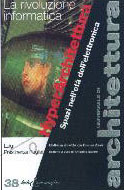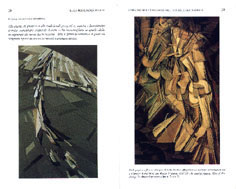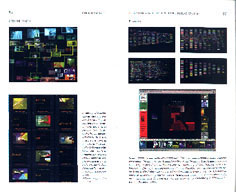 III
III
Ecaade Conference, Paris 1998
I
"La rivoluzione informatica" ("The Information revolution") is the title of a new book series. Its Scope is to bring closer architecture and computers by providing intellectual and cultural tools to orient the reader in this fast growing field.
II III
III
The first book (Luigi Prestinenza Puglisi, Hyperarchitecture. Spaces in the electronic era) is an essay that combines a critical overview of most recent projects by Ito, Arakama, Koolhaas, Libeskind with epistemological consideration and researches coming from conceptual art.
IV
V

The second book (Gerhard Schmitt, Information architecture) deals with the foundation and future of Caad systems and with the developing lines of Caad research. Other forthcoming titles include: Virtual Terragni, How works the Eisenman Office, Design and Build with Computers and several others.To better understand the scope, character and goals of the book series, it follows my Afterward to the first book.
The talk is entitled HyperArchitecture and it is divided in 4 four Parts.
Fluidity Squared, Methaphorization, To Bill, Hypertext
Painter.
1.
Fluidity is the key word in information technology.
The single unit of information is not set on a support (stone, parchment,
papyrus, canvas, paper) but is made up of an electric impulse. It changes
at the speed of light, but it is above all the relationship connecting
it to other atoms which changes instantaneously. The world of information
technology is, in fact, like a mobile web, in which the fundamental elements
are the inter-connections. If this fluidity describes it, then it is the
dynamic quality which characterizes this world. We can regroup units, one
with the other, put them into a hierarchy of innumerable relationships
and create models. And, with the variations of an atom, verify change in
the entire system or, changing the sense, the order or interfacing of the
connections, forming different worlds.
Let's take the simplest of examples. Even if often we are not aware of it, we write differently on the computer. The brain moves faster, we can always improve and change the words, imagine more and create more metaphors, but how many clearly understand that it is precisely the interconnection which is the key? As always, it is artists who understand first. An avant-garde novelist, for example, writes by putting down a spontaneous and chaotic flow of events, stories and characters. He abandons himself like a torrent. On a mountain of data, he then organizes information in a data base structure ( "man, nature, Claudia" to the facts) and, by way of computer-guided research, builds associations, structures and narrative forms.
Thus various stories are born, from which can now be chosen the most significant. His universe is malleable.
2.
Now, it is clear that if we are dealing with architectural spatiality, where we must use a type of architectural "writing" to understand the meaning of the information technology revolution, the answer cannot reside only in the primary level, the atoms and their capacity for change, but must go deeper, right into their dynamic interconnection. It is this relationship, this pattern, as defined by Fritjof Capra, that is the real engine of this era, including architecture. But how?
Project, mutate, simulate; these are words run through by a subject which once again should be reflected upon: that of rhetorical figures of speech (oxymoron, metonymy and many others still, but let us stop, for simplicity, at metaphor). Rhetorical figures of speech, which develop powerfully specifically when writing on the computer, basically create actual interconnections, a method of relating various data in order to send messages and convince. The rhetorical figure of speech has a potentially dynamic aspect which other relations (cause-effect, first-last, above-below) do not have. If one says, "You are beautiful like the moon," the message is multi-directional: there is a key to reading it but others are possible (with variations in culture, moments, countries, etc.).
The messages of our electronic age are ever more metaphorical and ever less assertive. It is the enormous mass of information which imposes links, though freer, more open links. An example?
4
Advertising in the industrial world used to be assertive. This soap washes whiter; these jeans are more resistant.
We know that advertising today sends out messages which are all figurative, all metaphorical. It induces, substantially through the use of rhetorical figures of speech, an association between a series of elements and the product; frequently without even showing the product and often without even describing it.
5
The narration is bought first, the living utopia that the product promises, then its form, and it is absolutely taken for granted that this works. The container wins completely over the content.
But this process of metaphorization, induced by a sense which goes beyond industrial mechanisms to open up a freer and more multi-directional sphere of messages, this process based on the dynamic interconnections of the metaphor, permeates everything in our era. It is sufficient to look at the design and the sphere of architecture, itself more resistant to change.
A building is no longer good only if it works, is solid, spatially rich, livable, etc., but also because it recalls something other than itself. Libeskind traces a dramatic "Z" to tell the drama of the Holocaust; Eisenman, a dance of tellurian plates; Gehry, a cathedral in his Museum; Domenig cracks and fissures which collide with one another in his house.
6
7
8
We know that the process of metaphorization permeates
a large part of the architecture of today and that its fundamental field
is a new interiorization of the landscape and the relationship between
man and nature. This has been learnt, or almost. In order to go further
into still tough terrain, we must return to electronics and especially
its center: interconnections.
After the invention of the personal computer (we are speaking of around 1977), the first revolution in information technology occurred in 1984 with the wide-scale distribution of a revolutionary new operating system . The basis was, naturally, metaphorization.
No longer were there abstruse codes which appeared on an inanimate screen (Dos was a os of industrial age), but objects on a desktop-screen.
10
This method of proceeding by metaphor, a metaphor taken from the real world and applied to electronics, was also incorporated into the programs. There was a large table of instruments for design; to write, a ruler similar to a typewriter; to design, a universal drafting device. This first level of metaphorization was fundamental; since it introduced millions of people to using the computer, it was important that it become a standard on more platforms.
However, the second invention was even more important and so innovative that only today is its significance being effectively understood.
11
It was in 1987 and a genius, William Atkinson, after having made a substantial contribution to the construction of the metaphor of the desk, developed another new idea. Why not give the user not only a pre-packaged metaphor, but the possibility of creating metaphors himself? Why not work, in other words, with a metaphor "creating" tool?
So Bill created Hypercard, which is just that; a computer environment which creates metaphors. The user puts down information under any form (designs, writing, numbers, tables, animated sequences, three-dimensional objects and many others) and either at the same time, or later, performs two fundamental actions: creates the connections and organizes a metaphorical environment.
The most banal of these environments is the card, where
the information is contained and where, clicking on each, the user can
proceed in the network of relations; but along with the card, there can
be millions of other metaphorical environments.
12
The production of an artist is in his virtual studio, a virtual lesson is held on a blackboard, shopping is done at home in a real store, but more importantly the user can dream and build worlds which do not exist.
In brief, this is what is called Hypertext. The basis is the interconnection between the units of information and the creation of a metaphorical environment in which these interconnections are located. The end result is that the user has methods which are non-compulsory, non-sequential. He can follow courses already preset or find his own new one. In some way, it is as if the novelist mentioned earlier gave the data his structure of meaning and at the same time left the possibility open for the reader to create his own.
By now, this system is everywhere, since, while in 1987
it was only relegated to the single computer, internet today is a planetary
web which connects many worlds of information to each other.
Let us return to architecture and ask ourselves: can we also work in architecture on this second level? Can we work on an architecture which is not only metaphorical, but also a "creator of metaphors", which leaves its own decodification open, free, structured/non-structured and suggests and offers to the user the possibility of constructing "his own story"?
To put it briefly, the true end is not only the metaphorization of the first level, but that of the second. To manage not only to imagine an architecture which is fluid, metaphorical and open, which plays on the skin like new, immaterial sensors, which completely assimilates and values a multimediality which moves into systems of control and information, but which is above all capable of generating other metaphors and causing others to be generated, those of life and its advancement into this new dimension: the entire past and the entire future.
Can we work on this ambitious and very difficult concept as the frontier of our task? Finally, does a more adequate word exist than Hyper-Architecture to describe this challenge?
What can help us? Can it really be that this sense, this need, in a century so rich in events, personalities and geniuses, has not already been at least guessed at?
In the architecture of this last decade, several very important discoveries have been made regarding the figurative arts.
Gehry in his last period owes quite a lot to Boccioni and his concept of trajectory, to that force of going beyond the plastic quality of the isolated object toward an atmospheric vibration. Peter Eisenman has adopted more than one technique from the vibration of Duchamp and Balla. The dripping technique of Pollock is touched upon in various types of research into new forms of landscape and the construction of nature, but who has really understood the spatiality inherent in Kandinsky.
14.
Atoms and geometric worlds are inserted into his paintings in a liquid ameba, but these figures interconnect with lines, superimpositions, interconnections. The overall whole emanates energy and seems like a Hypertext because it can continuously move itself; it has a structure photographed in a brief moment, but its value is not the static moment of Mondrian, but rather in the possibility of evolving, being free and open.
Certainly, we know that without impressionist orientalism and the breaking of the square box, there would be no Wright, that the space of Braque foreshadowed the Bauhaus, that the energy of movement and expressionis deformation were related to Mendelsohn and Scharoun, that neo-plastic designs transmigrated almost directly into Rietveld and Mies. We know that artists have a spatiality which transmigrates into architecture.
But the fluid, liquid, submarine, metaphorical, symbolic and interconnected spatiality of Kandinsky (and Mirò and Klee) is, without information technology, impossible to conceptualize in architecture. With information technology, on the other hand, this become almost vaguely intuitable.
This is perhaps what we are attempting to do with this strange word: HyperArchitecture.